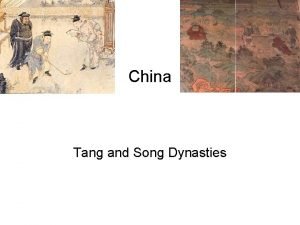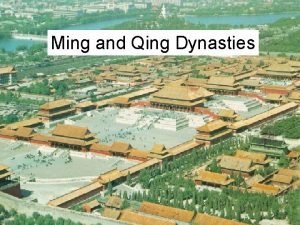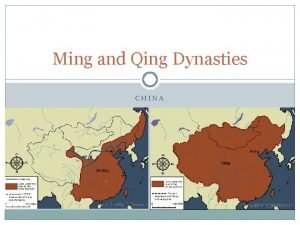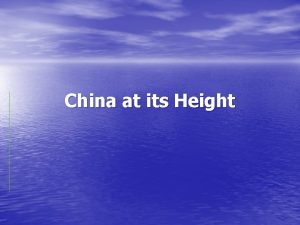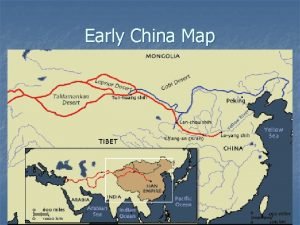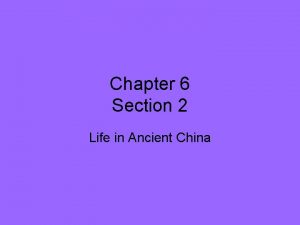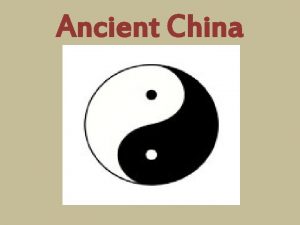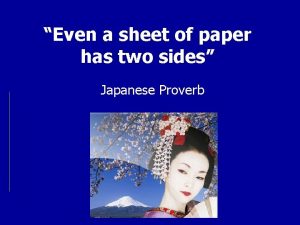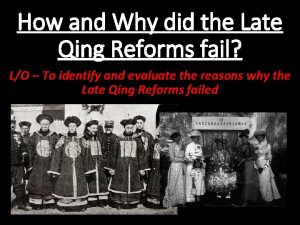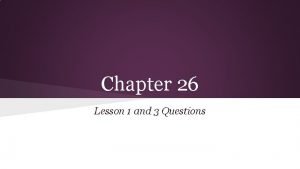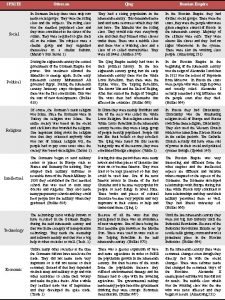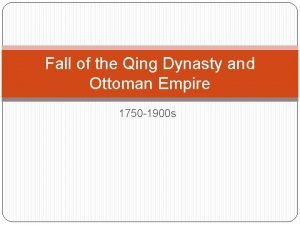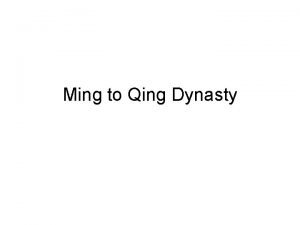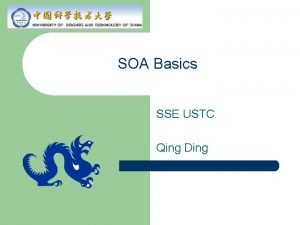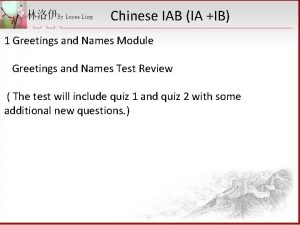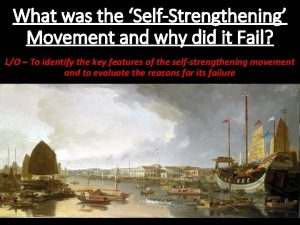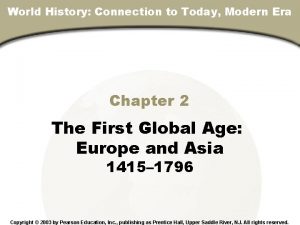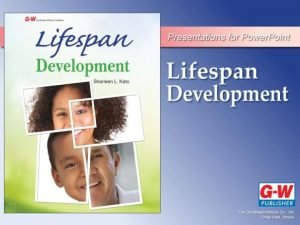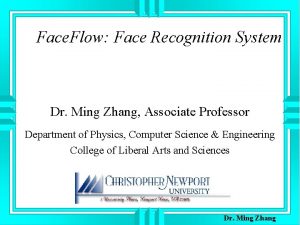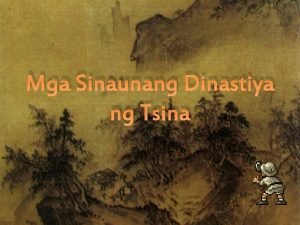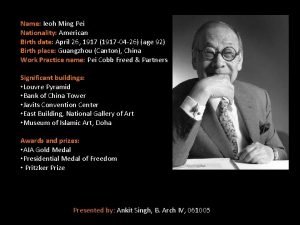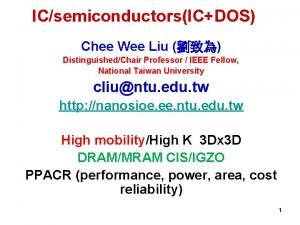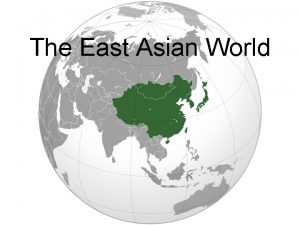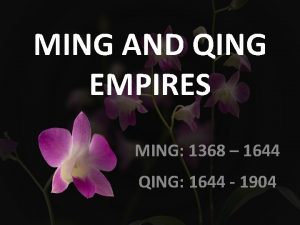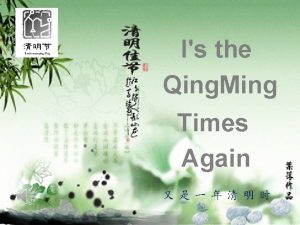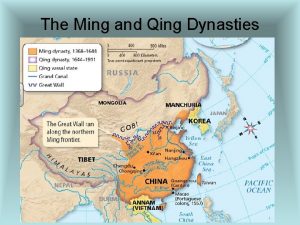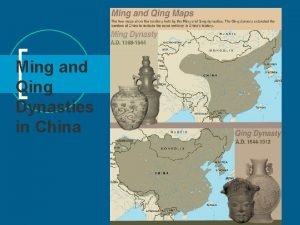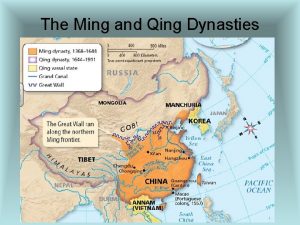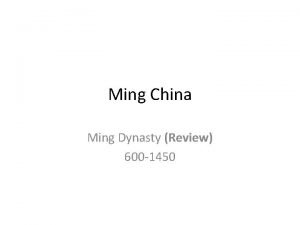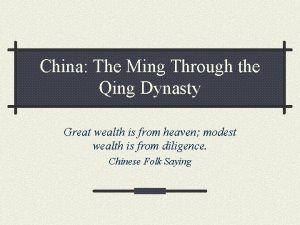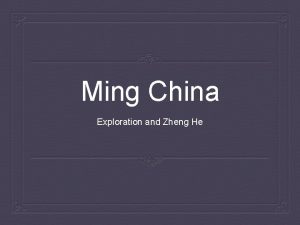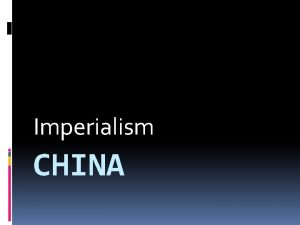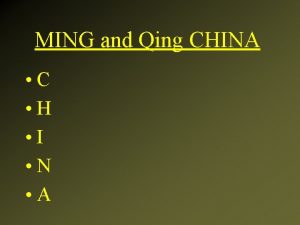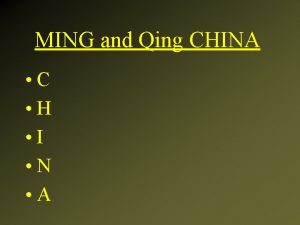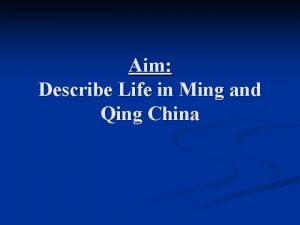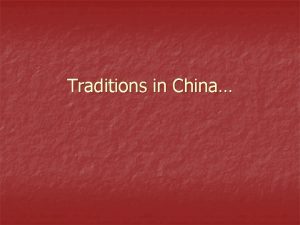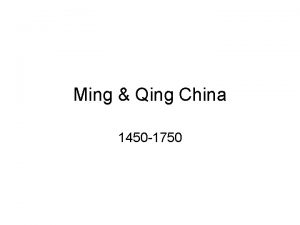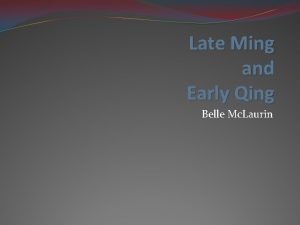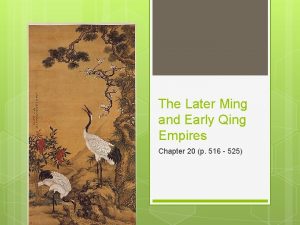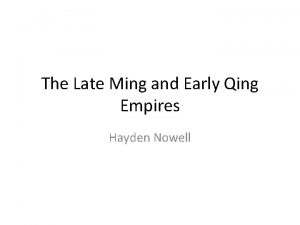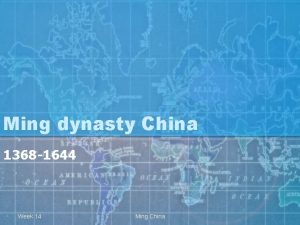China from the Ming through the Early Qing



































- Slides: 35

China from the Ming through the Early Qing Dynasty SSWH 4: d.

Time and Geography


Ming China, 1358 -1644 • Began with overthrow of hated Mongols who ruled China for 100 years • Last pure Chinese dynasty – lasted 300 years • Generally effective government • Sharp rise in population and food supply – New area of rice cultivation – New crops from Americas


ECONOMIC

Economic Progress under the Ming • Commercial activity steadily increased – Merchants socially inferior, but wealthy – Commercial contact with Europeans began • Portuguese in Macao The old south gate of the ancient city of Dali, Yunnan

Economic Progress under the Ming • Urbanization and Technology • • Enormous increase in urban population Failed to make leap into Industrial Revolution – Little emphasis on accumulation of material goods – Engineers, inventors never prominent – Confucianism did not admire capitalism Ming Chinese Canon

POLITICAL

Ming Political System • Government headed by powerful, but not divine, emperor ruling by Mandate of Heaven – Highly trained bureaucracy – China divided into 15 provinces – Occupations were hereditary: peasants, soldiers, workers – Palace eunuchs were dedicated servants The Ming Dynasty had a highly trained bureaucracy

Ming Political System Shenwumen Gate of Forbidden City, Beijing • Beijing again became capital with Forbidden City at center, a complex of palaces, offices, living quarters

The Gate of Supreme Harmony in 1900.

Bureaucracy by Examination • Exams were basis for entry and success in bureaucracy • Based in Confucianism • Only tiny minority successful at gaining office The decoration of two cranes on his chest is a "rank badge" that indicates he was a civil official of the first rank.

Bureaucracy by Examination • Strongly influenced education – Very narrow curriculum – Discouraged imagination, individuality • Created cohesive governing class with few differences in philosophy Candidates who had taken the civil service examinations would crowd around the wall where the results were posted; detail from a handscroll in ink and color on silk, by Qiu Ying (1494– 1552)

Dealing with Foreigners Great wall of China • Mongols – Huge army constantly ready to keep them out, maintained Great Wall – Two incursions, but both forced back

ECONOMIC

Dealing with Foreigners • Japanese – Hostility toward pirates, smugglers – Cultural, commercial interchange – Basically, China believed it needed little from outside


Dealing with Foreigners • Maritime Expeditions – Government-sponsored fleets went to East Indies, African coast – Made no attempt to colonize, set up trade network – Advanced seamanship, ship design, equipment Ming dynasty war junk from Zheng Ruozeng's Chouhai tubian (1562)

Dealing with Foreigners Map of the Macau Peninsula in 1639. • Westerners – Few trading enterprises with Portuguese, Dutch, occasional missionaries – Portuguese expelled for bad conduct, confined to Macao

RELIGIOUS

Dealing with Foreigners • Westerners – Missionaries tried hard to adapt doctrines to Chinese culture – Matteo Ricci, Jesuit’s most famous missionary, established Christian presence for a century Matteo Ricci

POLITICAL

Manzhou Invaders – Qing Dynasty • Ming went into decline in 17 th C – – Ineffective emperors Huge costs of officials Peasant rebellions Administrative apparatus ceased to function • Manzhou came from Manchuria – Admired Chinese culture – Gradually won support of mandarin class – When last Ming emperor died, Manzhou set up last imperial dynasty in China

Qing Government Location of Qing dynasty • Transition was relatively peaceful – China reached its largest size – Government positions filled by two people, one Chinese, one Qing – Strong reformers at first

Qing Government Portrait of the Kangxi Emperor in Court Dress • Kangxi – Contemporary of Louis XIV of France – Improved waterways – Active in economic policy making

Qing Government • Qianlong, grandson of Kangxi – Eradicated Mongol raiders – Treated Korea as voluntary satellite of China – Both he and Kangxi tried to keep Qing and Chinese separate The Qianlong Emperor in court dress.

AESTHETIC

Qing Culture and Economy • No break in fundamental cultural styles: philosophy, history, calligraphy, poetry, painting • Literature – new form – the novel – Dream of the Red Chamber is best known – Most authors are unknown • Fine arts – Porcelain extremely artistic, in high demand by Europeans – Scroll and screen painting popular – More people than ever were enjoying arts and education Dream of the Red Chamber:

INTELLECTUAL

Qing Culture and Economy • China lost lead in science and technology – More interested in sensitivity to beauty – Downgraded quantitative sciences and technical advances Qing dynasty warrior

Progress and Problems • Progress – Improvements in agriculture, engineering – Upsurge in internal trade • Problems – – Not enough work for expanding population Nearly all usable land was already in production Trade was narrowly focused on luxuries Began to experience massive famines and endemic poverty

REVIEW

Discussion Questions 1. Generally speaking, changes from one imperial dynasty to another may have meant few changes for most of the population. Was this also true in the transition from the Ming to the Manzhou? Were the various social classes in China better off under the Ming or the Manzhou? How? Why? 2. How would you compare the contemporaries Kangxi of China and Louis XIV of France? What similarities do you see; what differences? Which do you think did the best job of ruling and why?

 Qing qing hardware contacts
Qing qing hardware contacts Qing conquest of the ming
Qing conquest of the ming Rise of the qing dynasty
Rise of the qing dynasty Tang and song dynasty venn diagram
Tang and song dynasty venn diagram Qing conquest of the ming
Qing conquest of the ming Ming empire
Ming empire China at its height
China at its height Qing china at its height
Qing china at its height Song dynasty spice chart
Song dynasty spice chart How did the ming dynasty restore chinese rule to china?
How did the ming dynasty restore chinese rule to china? Chinese civilization map
Chinese civilization map China big idea
China big idea Chapter 6 section 2
Chapter 6 section 2 Why was wudi called the martial emperor
Why was wudi called the martial emperor Early cpr and early defibrillation can: *
Early cpr and early defibrillation can: * Lain orang lain ragam
Lain orang lain ragam Late qing reforms
Late qing reforms Chapter 26 lesson 1 the decline of the qing dynasty
Chapter 26 lesson 1 the decline of the qing dynasty Qing dynasty social classes
Qing dynasty social classes Fall of qing dynasty
Fall of qing dynasty Qing dynasty dbq
Qing dynasty dbq Qing ding
Qing ding Ming dynasty social hierarchy
Ming dynasty social hierarchy Qing wen nin gui xing
Qing wen nin gui xing Self strengthening movement china
Self strengthening movement china Chapter 14 section 1 the search for spices
Chapter 14 section 1 the search for spices The decline of the qing dynasty
The decline of the qing dynasty Chapter 7 early childhood ages 3 through 5
Chapter 7 early childhood ages 3 through 5 Child development early stages through age 12
Child development early stages through age 12 Cephalocaudal growth
Cephalocaudal growth Daughter of mary help of christ siu ming
Daughter of mary help of christ siu ming Faceflow
Faceflow Ano ang hsia
Ano ang hsia Ieoh ming pei philosophy
Ieoh ming pei philosophy Chee ming liu
Chee ming liu Rise of the ming dynasty
Rise of the ming dynasty



